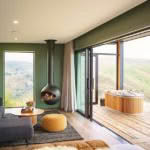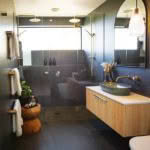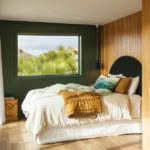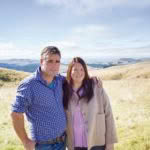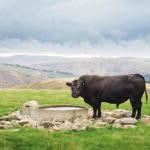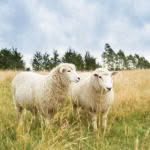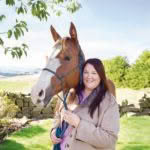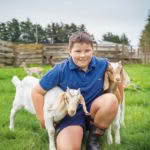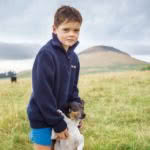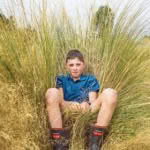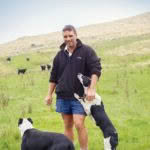A family in Waikouaiti have crafted a glamping haven under their farm’s tussocks
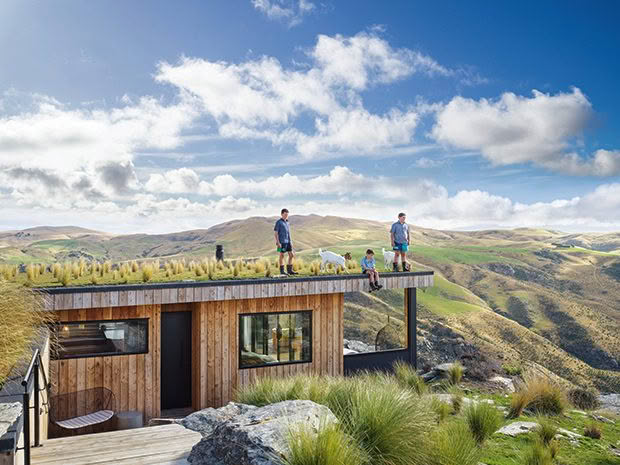
The three Smith sons, Hamish (12), Wade (7), Jack (10), and goats Dozer and Penny survey the lofty 360-degree views of rolling hill country from Fallow Ridge’s roof. Architectural subterfuge was the order of the day for this build. “Everything’s hidden,” says Dave, their father, who along with his wife Sarah, built the cabin. “There’s an air-conditioning unit in there, but it’s all ducted, so no one sees it. There’s a secret room down the back where we store everything. The tussocks are growing around the gas bottles and solar panels, and we’re leaving the larch cladding to silver off and match in with the rocks.”
What was once a rocky outcrop used by shepherds to clock their flock is now the site of an off-grid retreat high on an East Otago sheep and beef farm.
Words: Claire Finlayson Photos: Rachael McKenna
A soundtrack of real-time muted sheep bleats with cicada backing vocals: this is the face of “new luxe”. Or so Sarah and Dave Smith hoped when they took a nervous punt and built a posh cabin on a precipitous schist rock outcrop on their hill country farm.
They needn’t have worried. Agritourism has been going gangbusters recently — such is the modern-day hunger for remote and empty countryside. The fact many urban dwellers now seek luxury on high-country farms shows how thoroughly noisy our heads have become. As for the trend of farmers creating such sanctuaries to diversify their income, that’s a sign of how noisy our climate has become.
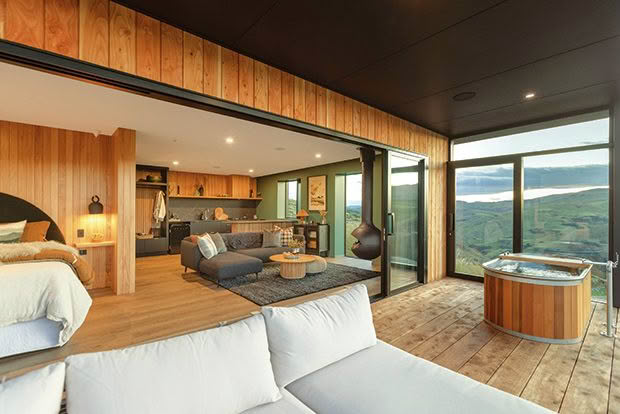
The interior fit-out was Sarah’s task. “I wanted it to be unique and different but not crazy. It still had to be cosy and appealing. I was nervous about the colour on the wall, but now I love it.”
The Smiths are well versed in the wobbly nature of farming life. They run 4000 romdale ewes and 300 angus cattle on a 1436-hectare property an hour’s drive north of Dunedin, inland from Waikouaiti. “The climate is so unpredictable now,” says Dave. “Sheep and beef farming is very up and down. Last year was great, but things have dropped by about $40 a head this year. While costs such as fuel, fertiliser, animal health and shearing escalated dramatically, the price we got for our product went down.”
That’s the beauty of their foray into tourism. It’s resolutely flood- and drought-proof. “The retreat doesn’t get affected by climate,” says Sarah. “It’s a whole different industry and it can slot into our farm. It helps cashflow all year round.” Dave adds: “At the moment, it’s very dry, and all our lambs have had to be offloaded. But we have every night booked at the retreat, so income is still coming through.”
- The silence and sense of isolation at Fallow Ridge Retreat is giddy-making.
Four years ago, the Smiths decided to hedge their farming bets and let forestry and tourism safeguard their income stream, allowing them to utilise chunks of steep, agriculturally unproductive land. Their first task: planting 270 hectares of Pinus radiata, which will mature apace with their three young sons Hamish, Jack and Wade), giving the couple time to develop a harvest plan that meets safety and environmentally prudent ends.
“We spent thousands trying to keep the gorse and broom at bay,” says Dave. “There’s a lot of slip-prone land that would start disappearing if we did get a bit of rain, so hopefully, the trees will stabilise it. It’ll generate a good income from carbon sales and offer succession opportunities for our boys when the timber is harvested.”
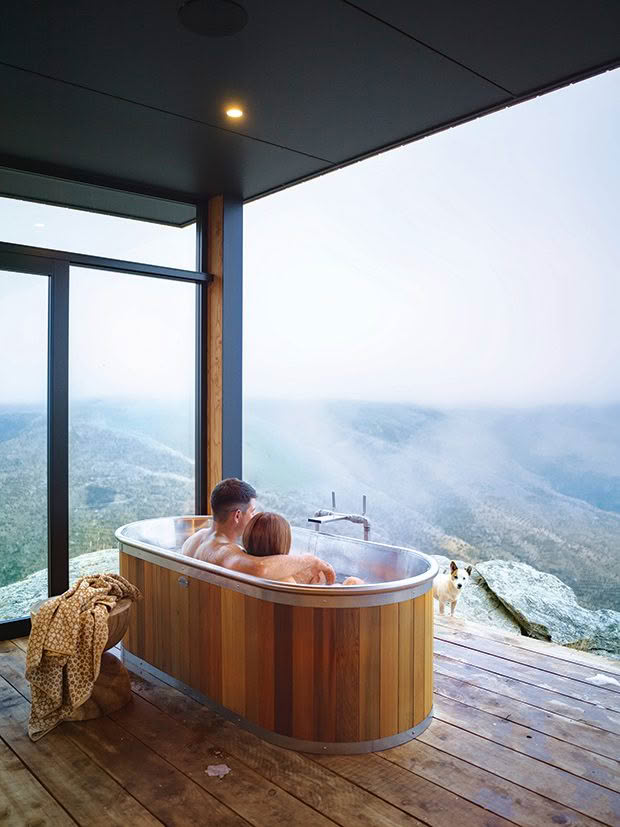
The only living creatures who might spot guests clambering out of the outdoor bath are the fallow deer (the retreat’s namesake) that dart about on the distant ridge — and they’re discreet enough to look the other way.
Tree planting was a cinch compared to the construction of Fallow Ridge Retreat. But then they were determined to build a cabin that looked like it had emerged from the earth. It was also the proper, geologically respectful thing to do given that to get to the Smiths’ property, one must curl around the side of a commanding 616-metre volcanic protuberance (Mount Watkin/Hikaroroa).
They chose a stunningly tricky site: a great hunk of unforgiving schist elevated enough to clock a glut of views — undulating East Otago hills and gullies, the Waikouaiti River, Mount McKenzie, Mount Trotter, the Kakanui Range, the top of Macraes Flat and the Silver Peaks.
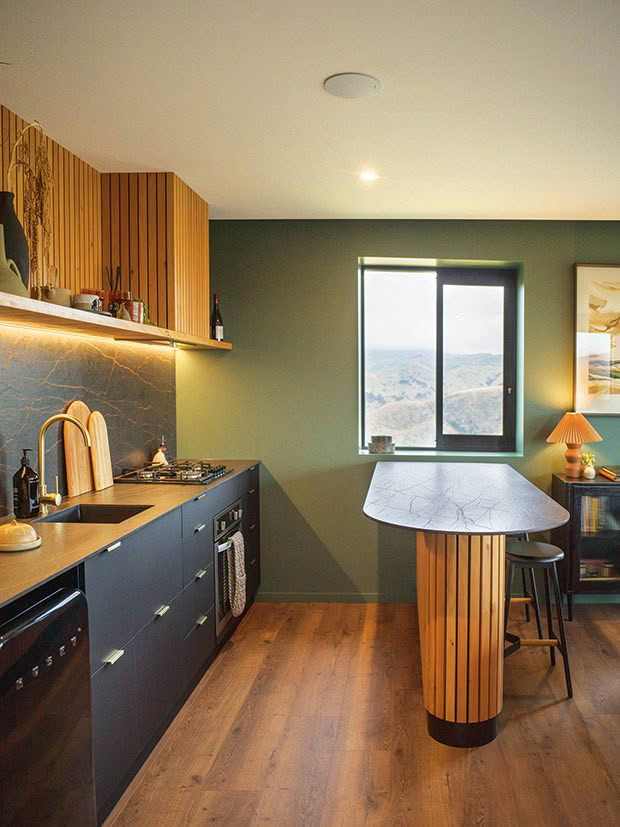
The digger didn’t like the schist and gave up when it hit rock, so Dave and his builder brother Matt tagged in. Dave recalls one particularly toilsome day: “It took eight hours to jackhammer one hole for a portal. I had to wear motorbike goggles to keep the dust away.” How did he feel at the end of that? Sarah’s verdict: “broken”. Dave, in laconic form: “The beer was quite good that day.”
The beer was good for quite a few days after that, too. What was supposed to be a three-week jackhammer job to create sturdy steel foundations turned into a three-month slog. Was there much swearing from the Smith brothers and provisioning of high-quality morning teas during that phase? Sarah says, “I think I did bring pretty good smokos down on those days.” Of the post-jackhammer sibling relationship, Dave says, “We’re still talking.”
It was worth it, though. All that steel allowed for what they most wanted: a living roof that could handle a good southern snow load and hide 53 square metres of off-grid cabin. “The design of the place started with the living roof,” says Dave. “That was our first idea. Then we built everything into that.”
They chose larch cladding, and a macrocarpa deck to extend the unobtrusive, rustic vibe of the exterior and then went all out on a swanky interior. Dave outlines the division of labour: “Basically, Sarah did the interior; Matt did the building. I just did what I was told in between the two of them.”
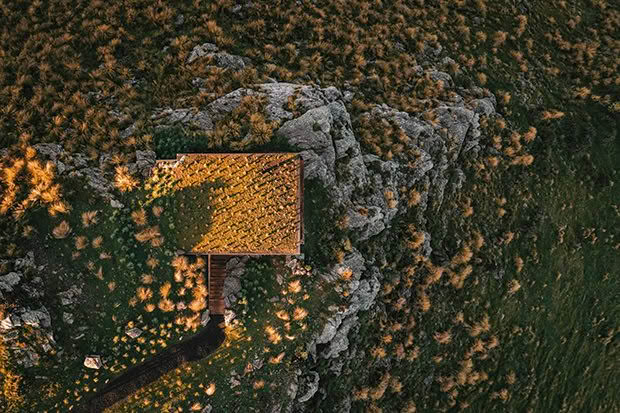
From above, the retreat is cunningly camouflaged. Dave and Sarah can’t wait for the day when the baby tussocks start to nudge each other and colonise the entire living roof.
They planted the roof with tussocks to match the surrounding hillside, perfectly confounding unsuspecting guests arriving at their destination to see what looks like a jutting angular hunk of earth. “We wanted it all to disappear into the land so when people turned up, they’d be like, ‘Well, where is this place?’ You don’t see the views until you walk through the front door. It’s all hidden. As are the gas bottles and solar panels.”
The retreat’s polite subservience to the landscape was highly necessary, for Sarah’s connection to this place is long and deep. Her parents spent many years farming Mount Watkin, so her childhood is mapped onto the surrounding hills. When her family sold the farm, she headed off to boarding school in Dunedin before studying business and commerce at the University of Otago. But then Dave happened.
- Sarah with her beloved horse Lilly.
- Jack with pet goats.
- Wade with dog Monty.
- Hamish testing the tussock’s fortitude.
- Dave on the farm with his two working dogs, Jess and Neve.
His parents had purchased Sarah’s old farm and were keen for him to run it, so Sarah boomeranged back there, her mustering gumboots still warm. “We met while I was in my second year at university,” says Sarah. “And in my final year, I swapped my lovely flat in Dunedin for my old room at the farm.” Despite Dave’s wooing skills, Mount Watkin/Hikaroroa wanted Sarah back in its orbit. “I think that volcanic peak must have some magnetic pull on me,” she says.
“There are still so many little reminders of my childhood here — from my initials scratched into the silver birch tree in the front yard to Mum’s hand-drawn farm map in the office. The trees I helped plant are still growing, and paddocks bear the names my parents gave them all those years ago. When Dave and I are out mustering, I often follow the same path my sister and I took when riding our ponies and chasing the sheep on our beat with our homemade rock shakers.”
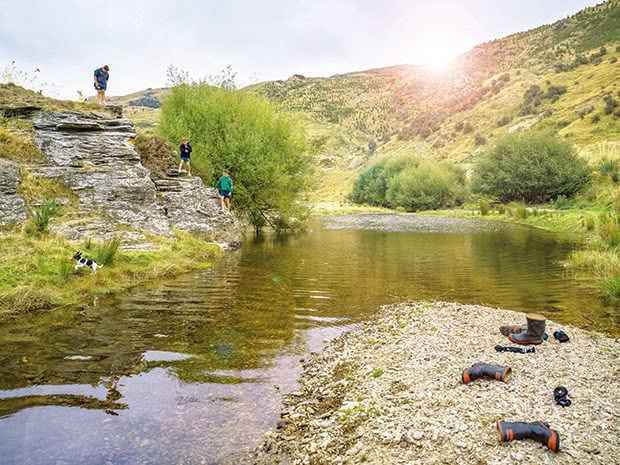
The Smith boys relishing their private river spot. “The Waikouaiti River is a major water source and important feature to protect on our farm,” says Sarah. “We fenced it off from stock and planted 3000 natives on its banks.”
Sarah says her parents weren’t convinced their old farm would attract high-end tourists. “They’d never have believed such a retreat would be sitting atop the musterers’ rock in their old ‘zigzag’ block at Mount Watkin. They were sceptical at first. They thought no one would want to drive up that 13-kilometre gravel road. Dad was still saying that until he saw the bookings a month ago. But they’re proud we took a big risk, and that it’s working.”
Asked if the couple’s three sons had lobbied to swap the family’s modest farmhouse for the high-end luxury of the retreat, Sarah says, “They know they’re not allowed in there. I told them that when they’re older and have girlfriends, they can stay. Maybe.” For now, they’re more interested in finding the keys to the secret room down the back where Sarah stores sweet treats for guests.
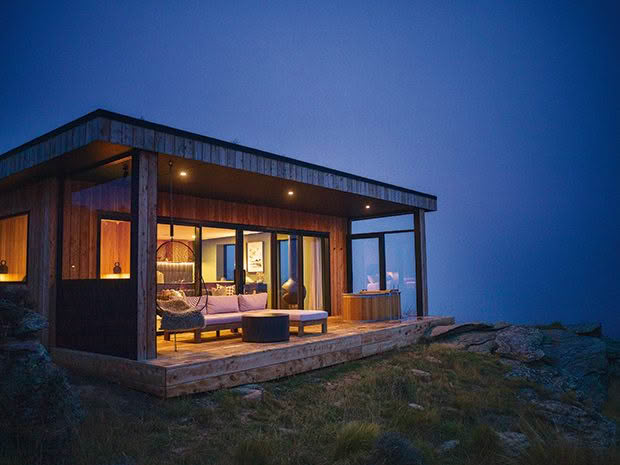
The Smiths wanted the retreat to withstand the brisk southern temperatures while maintaining its off-grid cred. “It’s all solar-powered”, says Dave. “We worried that it might not work on foggy days, but we had a guy design a good system for us, and it even generates enough for underfloor heating.”
Fallow Ridge has only been open for a few months, but the clamour for bookings has been strong and swift. Is it time to build a second cabin?
“Possibly,” says Dave. “We have another spot in mind. It’d have the same peace and quiet — just a different vista.” When the schist dust has gone from his motorbike goggles, he may start thinking about it more seriously. His brother Matt has already indicated that his jackhammer tolerance and sibling goodwill could extend further.
The smokos would need to be next level, mind.
MOUNT WATKIN WETLAND
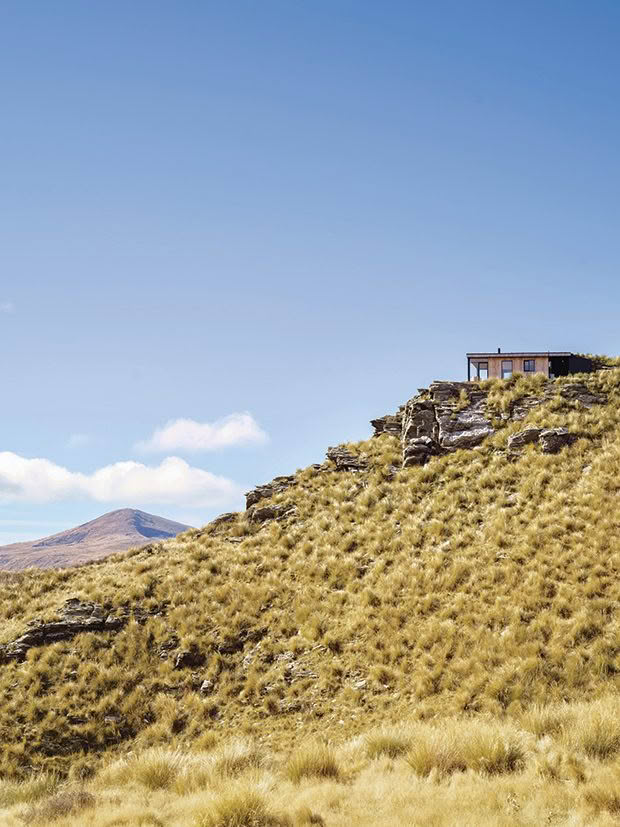
It’s not all sheep and beef on the Smiths’ farm. The pair have also created a wetland a stroll’s distance from Fallow Ridge Retreat that provides aquatic lodgings for a range of non-hoofed visitors: grey teal/tētē-moroiti, new zealand shoveler/kuruwhengi, new zealand scaup/pāpango, welcome swallow/warou, harrier/kāhu, paradise duck/pūtakitaki, freshwater crayfish/kōura, and frogs/pepeketua.
They established Mount Watkin Wetland in 2012. “It was a seven-hectare wet area that cattle got into,” says Sarah. “We didn’t want them in there, so we teamed up with the New Zealand Game Bird Habitat Trust, built two dams and planted natives. We registered it as a QEII covenant, so it’ll always be protected. There’s a wee seat there that Fallow Ridge guests can wander down to.”
Love this story? Subscribe now!
 This article first appeared in NZ Life & Leisure Magazine.
This article first appeared in NZ Life & Leisure Magazine.
